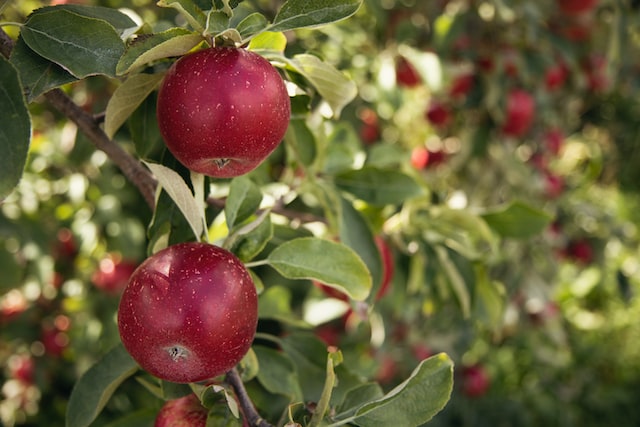The codling moth (Cydia pomonella L.) is the most important pest in intensive apple orchards. To control this pest, 1 to 2, or even up to 7 treatments are carried out annually. Therefore, most of the pest control measures in orchards are directed towards this species. It is estimated that it can cause damage amounting to 50% of the potential yield. Recently, its harmfulness has significantly increased, which is attributed to climate warming, causing the occurrence of this species to be earlier and more intense.
The pest attacks
Fruit.
Pest morphology
The adult form of the codling moth is a butterfly with a wingspan of 16 to 19 mm. It is gray in color. Near the tips of the forewings, there are very distinct and characteristic brown patches bordered by two shiny dark reddish-golden lines. The hindwings are reddish-brown.
The eggs are 1 mm in diameter, round, flattened, and slightly swollen in the middle. Initially milky-white in color, after a few days, a reddish ring appears on the periphery.
As soon as they hatch from the eggs, the caterpillars are 2 to 3 mm long, and their head is twice as wide as their body. They grow to be 16 to 20 mm long. Their head is dark brown, and their body is initially whitish, later becoming light pink to reddish.
The pupa is 10 to 12 mm long and 3 mm wide. It is yellowish-brown to dark brown in color. It is found inside a silky cocoon.


Biology and Life Cycle of the Pest
The adult caterpillar overwinters in a cocoon beneath the bark and in various cracks on the trunk and thicker branches. In April, it pupates at its overwintering sites. The emergence of the moths begins in late April, becomes more intense in May, and continues until the end of June. Adult moths live an average of 15 to 18 days. Males emerge before females. Moths mate and lay an average of 30 to 50 eggs when the temperature is above 15°C, soon depositing them on the surface of leaves, twigs, and fruits. The incubation period lasts 7 to 14 days. Once hatched, the caterpillars burrow into the fruits where they develop. Development takes 20 to 30 days. The mature caterpillar then leaves the fruit and spins a cocoon in various cracks on the trunk and branches.
After about ten days, the moth emerges, which flies from mid-July to mid-August, laying eggs on the fruits into which the caterpillars then burrow. During the ripening of the fruits, the caterpillars emerge and move to their overwintering sites (cracks in the trunk, soil).
In Croatia, the codling moth regularly has two generations.
Damage caused by the codling moth
The larvae cause damage by burrowing into the fruits, typically near the calyx or stem of the fruit. Initially, they damage the fruit superficially, but later bore tunnels all the way to the core where they feed on the apple seeds. The tunnels are filled with excrement, which they eject through an opening. Infested immature fruits often drop prematurely, while those that remain have significantly reduced quality due to infestation. Infected fruits are also often affected by fruit rot (moniliosis).
Protection against the codling moth
Trapping belts are one of the methods used to protect orchards from the codling moth. When the larvae of the first or second generation go to pupate or overwinter, trapping belts are placed on the tree trunks. These belts are removed every 10 days during the summer, and at the end of autumn, and the larvae caught in them are typically destroyed by burning.
Fallen unripe fruits, as well as those containing larvae, should be collected and destroyed.
After harvesting the fruits, codling moth larvae can be brought into storage facilities where they spin cocoons and overwinter. In this case, it is necessary to destroy the larvae before the moths start to emerge or to prevent the moths from leaving the storage by placing nets on the windows and treating the walls with dichlorvos.


The codling moth has many natural enemies, such as lacewings, stink bugs, and certain types of beetles, making biological control of the moth possible.
It is also possible to apply a bioinsecticide based on B. thuringiensis.
Preparations containing agents causing viral infections of the codling moth have shown satisfactory effectiveness.
In biotechnical methods for controlling the codling moth, the use of pheromones should include one of two methods: “attract and kill” and mating disruption.
Effective among biotechnical insecticides are toxicologically and ecologically acceptable insect growth regulators based on chitin synthesis inhibition. These are applied at the beginning of caterpillar emergence from eggs.
Analogues of juvenile hormones should be applied at the egg stage or in the final larval stage, whereas the application of anti-juvenile hormones is less dependent on the timing of application.
For initial treatments with chemical insecticides, it is recommended to use products with longer residual action, while for final treatments, the choice depends on the harvest date, using insecticides with appropriately shorter pre-harvest intervals.
To spare the fauna of natural enemies, it is necessary to use selective insecticides instead of universal ones.
Curative control is carried out in spring, after moth emergence, i.e., immediately at the beginning of caterpillar emergence and before their boring into the fruit.













































